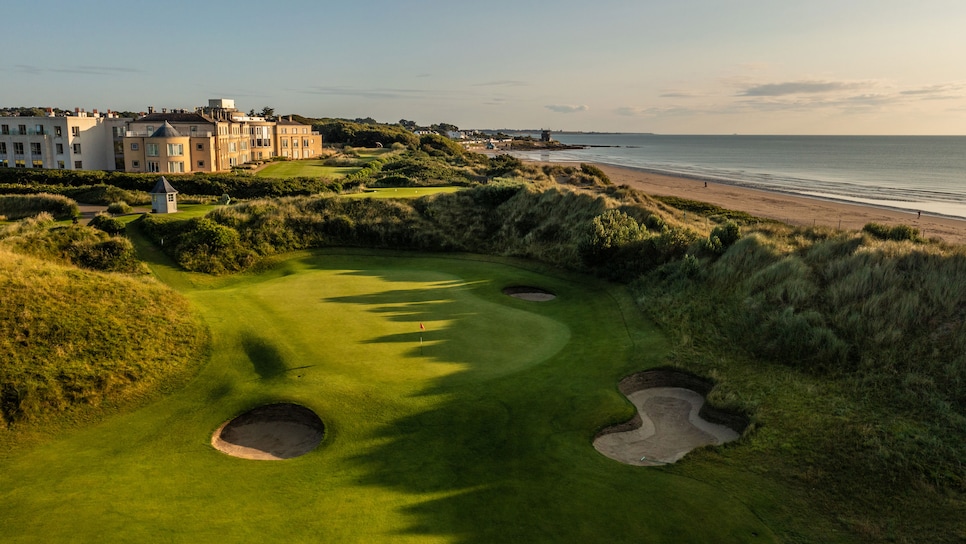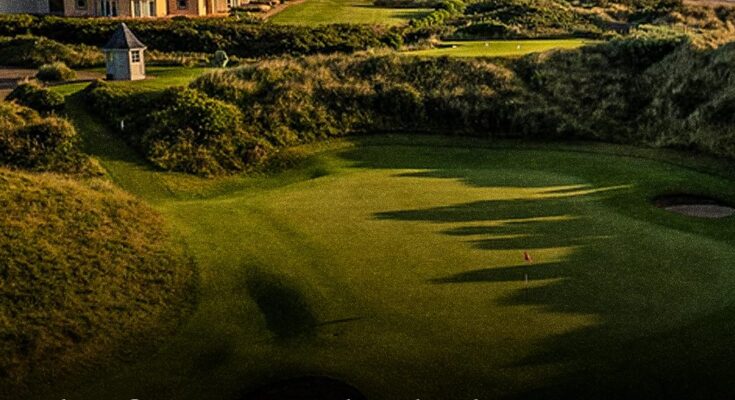Jack Nicklaus, in all his strategic wisdom, once described the Old Course at St. Andrews as a layout where, “Most of your problems are to the right.”
At the Portmarnock Resort & Jameson Golf Links, just outside Dublin, the sentiment is similar for drives on many of the holes routing along its rugged and handsome links overlooking Ireland’s Eye and the Irish Sea. Especially the first tee shot, where 15 yards right of the fairway sits several gravesites including that of John Jameson III—the great grandson of John Jameson, founder of the iconic Irish whiskey brand in 1780.
Whiskey and golf are synonymous with the Emerald Isle, but few realise how closely the two are linked—until they slice a drive off the stunning, 365-yard par-4 opener. (The graves are out of bounds, by the way, so best to hit a 220-yard layup from the tee short of a burn running through the fairway.)
Jameson III was among the first people to introduce the game of golf to Ireland in the mid-19th century. In fact, he constructed one of the first known courses in Ireland.
Royal Curragh Golf Club, in County Kildare, has been widely accepted as having hosted the first recorded round of golf in Ireland—a match in 1852 featuring the visiting captain of Prestwick Golf Club (site of the first British Open, in Scotland)—and it was formally founded in 1858. Jameson III, however, constructed a private, nine-hole course on land at Portmarnock, 25 minutes outside Dublin, at some point in the 1850s, for family and friends. With Royal Belfast not being formed until 1881 and Royal Dublin in 1885, it renders the original Portmarnock nine-holer one of the oldest courses in Ireland. The course ran from near the family home, which forms part of the modern clubhouse, out across the peninsula to dunes that now shelter the 15th hole at neighbouring Portmarnock Golf Club.
Carol Quinn, the head of archives for Jameson Whiskey, confirmed with Golf Digest that a nine-hole course was built in the 1850s although the exact year cannot be determined. What Quinn has been able to document is that Jameson III purchased 600 acres of land and built a house in 1847, overlooking the ruins of the ancient church of St. Marnock. He constructed the golf course several years later.
Jameson III, who died in 1881, as well as his son, John Jameson IV, used the nine-hole course to kickstart Dublin’s golf scene including a direct contribution to the country’s most famous links masterpieces: Portmarnock Golf Club. Jameson IV leased land at the southern end of the peninsula to founding members of Portmarnock, which opened in 1894 with Jameson IV serving as president of the club. Once Portmarnock opened, the Jameson nine-holer was no longer maintained, nor was the discourse of its place in Irish golf history. Three holes from the original nine were incorporated into the present links: the eighth, ninth and 15th. Across the bay from the Jameson Links, The Island Golf Club was founded in 1890 only five years after Royal Dublin.
“Founding members of those early golf clubs likely would have played golf at our original nine-holer and would have known the Jameson family,” said Paul McCanny, Director of Golf at Jameson Links.
The golf origins of the Jameson family property were revived in 1995 when three-time Irish Open champion, and dual Masters winner Bernhard Langer designed an 18-hole links course. A year later, a hotel opened on-site with Sir Tony O’Reilly and IMG founder, Mark McCormack, among its owners. The resort was named the Portmarnock Hotel and Golf Links.
Its reputation was jumpstarted in 2019 when world-renowned Canadian hospitality group, Northland Properties, which is owned by the Vancouver-based Gaglardi family, bought the hotel and golf course. The property was renamed the Jameson Golf Links and Portmarnock Hotel in 2023.
Jameson Golf Links and the Portmarnock Hotel. (Photo courtesy of Jameson Links)
McCanny said the property’s history had been thoroughly restored. “It’s really special, through our name and the different restaurants, rooms and bars within the resort, to celebrate the fact the Jameson family were so pivotal to introducing golf to the island of Ireland,” McCanny, who hails from Derry, told Golf Digest. “That connection between the Jameson family and golf isn’t talked about enough. The Gaglardi family were eager to invest in the property and make it a destination for golf and recreation.”
Planes landing in Dublin fly almost over the golf course as the airport is 20 minutes from the resort. “I believe we’re actually the only links golf resort within a capital city in the world,” McCanny said. “We’d all like to see it among the top golf destinations in Ireland. We want to be among the top golf resorts in Europe.”
Should neighbouring Portmarnock be successful in securing the first Open Championship held outside the United Kingdom—a proposal that is gaining serious discussion inside the R&A with an announcement potentially coming as early as next week at Portrush—the Jameson Hotel would likely be involved in the championship’s operations.
“We see ourselves as a friendly neighbour and if there’s anything we can do to help, we will,” McCanny said. “We have a great relationship with Portmarnock and we have a deep historical connection with them.”
Given that connection was established by Jameson III, it would be fitting that the Open would be played on a peninsula he originally saw a potential for golf.
Is it the British Open or the Open Championship? The name of the final men’s major of the golf season is a subject of continued discussion. The event’s official name, as explained in this op-ed by former R&A chairman Ian Pattinson, is the Open Championship. But since many United States golf fans continue to refer to it as the British Open, and search news around the event accordingly, Golf Digest continues to utilize both names in its coverage.


